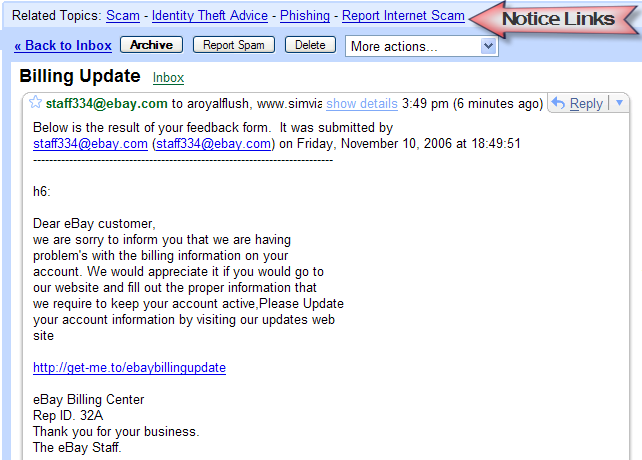November 30, 2006
Fun Things to do in Southern California with your Parents?
My parental units are coming out to California in a few weeks. This will be their third (or fourth?) trip out and we're planning to head to the southern half of the state for a change. We've seen much of the local and northern stuff.
They've been dutifully looking through the AAA Tour Books, making list of things that might be interesting, sending me a list for comments, and so on. But I figure that there may be a good handful of people reading my site who can suggest things that may not have made it into the AAA books (or which they may downplay too much).
So, aside from "Christmas than Death Valley" what would you want to make sure your parents saw in Southern California on their first Winter Vacation out here? A favorite ghost town? The largest ball of twine? A famous stretch of beach? Wally World? Paul Kedrosky's driveway?
Anything is fair game at this point...
November 29, 2006
My Favorite Corporate Blogs: Garmin and Zillow
I find myself reading more "corporate" blogs (those associated with a company and not a single person) now than I thought I might a year or two ago. And, sadly, most of them suck.
Among the sins they commit are:
- sucking the humanity out of blogging--or, even worse, faking humanity in formulaic and predictable ways (often the result of too much PR or Marketing influence)
- writing only to draw attention to themselves (again, PR and Marketing)
- writing only when they need to announce something (again)
- not allowing comments
- infrequent posting
But rather than name the big offenders, I figured it'd be more useful to highlight those I think are doing a fantastic job. In my mind, two of the best are the Zillow Blog and the Garmin Blog. Our own YPN Blog is a runner up in my mind, but I'm really too close to it to be unbiased.
What do I like about these blogs?
- there's some personality in the writing
- they write about stuff that's interesting to me (or they write it in an interesting way, and that gets my attention)
- they post frequently
- they write about stuff that's not always blatantly self-promotional
Do you have favorite corporate blogs that you subscribe to or visit on a regular basis? What are they? Why?
November 28, 2006
Porn Makes You Want Less Real Sex
I guess this is no real shock if you think about it for a few minutes, but a story titled The Porn Myth in New York Magazine examines the effect of readily available high quality porn on the sexpectations of the current generation.
It's a sad tale that would have surprised people even 10 or 20 years ago when it was apparently common knowledge that exposure to pornography created sex hungry men:
But the effect is not making men into raving beasts. On the contrary: The onslaught of porn is responsible for deadening male libido in relation to real women, and leading men to see fewer and fewer women as "porn-worthy." Far from having to fend off porn-crazed young men, young women are worrying that as mere flesh and blood, they can scarcely get, let alone hold, their attention.
In other words, the fake stuff has raised standards so far that it's hard for real women to compete!
And they know it...
Here is what young women tell me on college campuses when the subject comes up: They canít compete, and they know it. For how can a real woman--with pores and her own breasts and even sexual needs of her own (let alone with speech that goes beyond "More, more, you big stud!")--possibly compete with a cybervision of perfection, downloadable and extinguishable at will, who comes, so to speak, utterly submissive and tailored to the consumerís least specification?
Yikes.
While the entire article is worth a read, I can summarize it using one short quote from the first page:
For most of human history, erotic images have been reflections of, or celebrations of, or substitutes for, real naked women. For the first time in human history, the imagesí power and allure have supplanted that of real naked women. Today, real naked women are just bad porn.
In related news, check out the story of the stunning size 12 model branded 'too fat' for television. There's a picture of her and the apparently "more ideal" model on the page. It's a stark and somewhat depressing contrast.
November 26, 2006
What a Difference Six Hours of Flying Makes
 A couple weeks ago in Short Field Landings and Learning Plateaus I lamented my inability to comfortably fly the Citabria slow enough on final to perform a short field landing without floating right past my intended touchdown point.
A couple weeks ago in Short Field Landings and Learning Plateaus I lamented my inability to comfortably fly the Citabria slow enough on final to perform a short field landing without floating right past my intended touchdown point.
The following weekend, I managed to fly about 4.2 hours for the sole purpose of getting my speed down in a comfortable way. Thanks in part to the helpful comments in response to that post, here's what I did.
- flew down to Hollister on Saturday, climbed to 5,500 along the way, and practiced flying between 55 and 65mph with the engine idle for a good 10 minutes
- worked on flying slower during final and landing, by moving my comfort zone down a few mph every 3-4 landings
- practice over and over
- completely ignored picking a spot to land on, instead focusing completely on simply making the runway and controlling speed
It worked.
I flew again with my instructor last Wednesday and after he gave me a few pointers on controlling my touchdown point (use small power changes to adjust it), I started nailing my short field landings within the -0/+200 practical test standards.
Woohoo!
In retrospect, it is all quite easy.
I thought I was going to practice a bit more on my own this past Saturday, but when I arrived down at South County airport, I encountered winds that were variable from about 10 to 15 knots and anywhere from straight down the runway to a 40 degree left crosswind.
Doh!
I was dismayed, but decided it was a great chance to try a few "normal" landings to see how I could handle the crosswind. Surprisingly, I had a blast doing this and stuck around far longer than I expected. In total, I logged 11 landings down there and only had to go around once.
My fear of crosswind landings in the Citabria is starting to fade, and that's a very good feeling. I now feel like I have a lot more control in my landings than I ever have before.
Yay!
Please don't confuse blogging with the echo chamber
Now and then I see people write about "blogging" when they're really talking about the less than 1% of blogs that find themselves writing about each other in an almost herd-like and insular fashion sometimes. Often they'll all devote many bits and bytes to some trivial topic of the moment related to Google, blogging, Microsoft, patents, or government.
I like to think of this small subset as the "echo chamber" that is occasionally written about in regards to blogging. They're the ones who often appear on echo chamber amplifiers like the Technorati popular blogs, Techmeme, and similar services.
So when someone as bright as Jeff Sandquist says something like this, I have to pause and think about what he really means:
TechMeme.com has become a critical part of the blogging plumbing and is a site I visit many times throughout the day to keep up with what is happening in the tech industry.
I think that "critical part of the blogging" is a bit of an overstatement, given how few blogs ever appear on TechMeme. But at the same time, I know what he means. In context it's clear that TechMeme is critical to people, like Jeff, who want to keep up with what's happening in the tech industry (or at least what people think about what is apparently happening).
Don't get me wrong. TechMeme is a useful service for many people. I used to be one of them. But I lost interest a while ago when it became far less useful for discovering stuff on that long tail of blogging. Anymore, a small subset of blogs (and increasingly non-blogs) hog much of the attention. That happens to be exactly what I'm not looking for most of the time.
Disclaimer: This blog tends to participate in the echo chamber more than I'd like. I've been trying to fix that in recent months, but it's hard to go cold turkey.
November 21, 2006
Amusing Vacation Auto-Responder Email
Do you get sick of reading the same old auto-responders from co-workers who are out of the office? I sure do.
When I go away for more than a few days, I tend to set up an auto-responder that's slightly less boring that the normal "I'm out of office with occasional access to email until ..."
I just configured mine, since I'll be elsewhere for the next few days:
I'm out of office for the ritual slaughter of turkey and will have only occasional access to email. You have been warned. :-)
Now, I fully admit that these may be amusing only to me. But that's never really stopped me from trying. Being able to amuse yourself is sometimes the only way to stay sane.
I've found that it's best to keep 'em short, otherwise nobody will read it all the way to the end.
Do you use a non-standard message to notify people of your absence via email? If so, what is it? Or what's the best one you've seen?
Fact Checking CNet's Yahoo! Developer Network Story
While I'm happy to see CNet writing about the Yahoo! Developer Network in Yahoo seeks geek credibility, the article contains several factual errors--you know, the kind that can be easily checked by googling.
Fist off, Brad Garlinghouse did not co-found Flickr.
But that steady stream of acquisitions has created overlap with other Yahoo properties, a problem highlighted by Flickr co-founder and now Yahoo senior vice president Brad Garlinghouse in a leaked memo called the Peanut Butter Manifesto.
The co-founders of Flickr were husband and wife combo Stewart and Caterina, as is evidenced by Newsweek a few months back.
Secondly, the Yahoo! Developer Network has been around far longer than "last March."
Web heavyweights Amazon.com, eBay, Google and Microsoft have made developer loyalty a high priority. Yahoo, which launched its Developer Network last March, has taken that tack as well.
I searched for "yahoo developer network launch" and found a page full of announcements from February 2005. That's nearly two years ago.
Update: The story has been corrected. Good to see a quick turn-around on CNet like that!
November 20, 2006
Yahoo's Peanut Butter APIs
 Over the weekend someone sent me email that, among other things, said roughly: "Iím glad to see that APIs weren't on the list of things Brad Garlinghouse wants to get rid of. That means you're safe, right?"
Over the weekend someone sent me email that, among other things, said roughly: "Iím glad to see that APIs weren't on the list of things Brad Garlinghouse wants to get rid of. That means you're safe, right?"
I thought about that for a few seconds and the replied with something like this:
If part of Yahoo's problem is that it tries to be everything to everyone (and it is), then APIs are part of the solution. By offering up web services that encapsulate the core things we're really good at, we'd be able to stop trying to be everything to everyone. Why? Because others would have the raw materials needed to come in and fill the gaps (or the "long tail", if you prefer). We'd be part of the solution without necessarily having to do all the work.
That's how I see it.
Now, if you're one of the people who's asked me what I think about all this... here's my answer: Brad is very right about some things and terribly wrong about others.
November 13, 2006
Job Listing Syndication Experiments
One of the many types of email that manages to clog up my inbox is the regular stream of recruiters looking for good engineers. Occasionally they're interested in recruiting me, but all of the time they'd appreciate it if I could pass the word on to others I know.
Unfortunately, that doesn't scale well.
And this has been going on for a long time now. A few times, partly out of desperation, and partly to see if they'd take the bait I've responded with something like this:
Honestly, I probably do know folks who are qualified and even interested in the position. The trouble is getting to them in a way that's not spammy or tiresome (I can't do it every time someone asks). And it'd be rude of me to just give you their email addresses. But if you're willing to pay $xxx, I'd be glad to post it on my blog...
I'd then go on the describe the readership and traffic characteristics of my blog and hope and pray that they'd say "no thanks."
Why?
Because I had no infrastructure in place for taking money, putting the listings up, and so on. It would have all been manual work and I was already too busy.
But I was curious. It felt like there might be demand... and opportunities for someone.
It was around the time that Paul Stamatiou wrote The Job Boards Boom that I sent out an exasperated email to a list of people that I figured would know if anyone had cracked that nut--someone who had built a simple self-serve system that solves exactly the problem I was having.
Amazingly, I quickly learned that there was at least one service already up and running. There are at least two more in late stages of development or testing.
So I've decided to start trying them out. You'll see technology job listings appearing on the right side of my individual blog posts (in the sidebar).
I'll write more about each service in future posts, including the one I'm using now. But I just wanted to point out that it's there so that nobody is surprised. And, if you're looking to hire, feel free to post a job. :-)
November 12, 2006
Short Field Landings and Learning Plateaus
 As a student pilot, you're told that learning comes in phases--phases that often have non-trivial plateaus between them. When you're on one of those plateaus, it seems not to matter what you try. You simply can't "get" the thing you're trying to accomplish.
As a student pilot, you're told that learning comes in phases--phases that often have non-trivial plateaus between them. When you're on one of those plateaus, it seems not to matter what you try. You simply can't "get" the thing you're trying to accomplish.
Until one day it just "clicks" and you can't remember how it was ever difficult to do that thing. It can be an amazingly frustrating experience. Sometimes there are things you can do to help move it along: trying a different technique, ask a different instructor for advice or an explanation, and so on. But more often than not, the answer is to simply keep trying.
I'm stuck on one of the final plateaus before my FAA checkride: short field landings.
My instructor and I practiced them a few weeks back and he recommended that I do some solo practice. I did that and then flew with him again last weekend. My short field landings were still not right. But, amusingly, the one wheel landing he asked for was the best I've ever done. And now I can't imagine how it was ever hard. (See above.)
The idea behind the short field landing is that you land a bit differently on a shorter runway (or field) than when you have a few thousand feet to spare. In the case of the Citabria 7KCAB I'm flying, that means flying about 60 mph after I bring the throttle back to idle on final. It means giving up a bit of margin, but doing so without giving up all your margin.
I practiced again today and the results were no better than last weekend when he and I flew together. Clearly I need to keep at it.
What I should be doing is flying an extended downwind leg, turning base, and then maintaining an altitude of roughly 600 feet AGL onto the final approach until I've got the runway made. This should all be done at a fairly slow speed, like 70 mph.
Once I've got the runway made, I should bring the throttle back to idle and try to hold the speed closer to 60 mph for my glide to the runway. My sink rate is higher at 60 than 70, so I'll be dropping faster than I'm used to. And the attitude is more "nose high" than I'm used to. And when I flare at 60 mph, I should have a lot less "float" than I normally do. That means I'm able to get on the ground using less runway.
But for whatever reason, I can't seem to hold my airspeed down. I suspect it's psychological. It just doesn't feel right, so I let the airspeed build up, float too far, and end up missing my aim point.
On the plus side, we may have found the source of the small oil leak. :-)
Suggestions from any pilots in the crowd?
Comment Confirmation Required
I've decided to experiment with alternative forms of comment spam moderation, filtering, etc. It used to be that MT-Blacklist would handle blocking spam for me and moderating comments on old entries. And my "type Jeremy here" challenge keeps most of the bots away (there are literally thousands of attempts per day). But it didn't do quite as good a job protecting newer entries where a human spammer was at the keyboard.
As of now, all new comments hit the moderation queue. However, you can bypass the need for me to approve your comment. When you submit a comment, my system will send you a small email to the email address you supplied. If you click the link in that email message, it'll approve the comment right away.
Simple.
Now, I may still approve or remove comments on my own, but this may prove to be a useful balance. We'll see.
It's worth noting that your email address is never made public on the site, so you shouldn't worry about it appearing. If you're not comfortable telling me your email address, I may not be comfortable approving your comment. It's that simple.
So if you've been a regular but anonymous commenter, you have a decision to make.
We'll see how it all works out. I'm interested in feedback on the system--including bug reports! I wrote a bunch of this myself.
BTW, I've known who the famous grumpY! is for a while now. :-)
Good Crockpot Chili Recipes?
Dear Lazyweb,
 I like Chili.
I like Chili.
Many kinds of chili: classic American beef, with corn, without, chicken, Black Bean and sweet potato chili with chocolate, and probably others I've not even sampled yet.
I own a crockpot (or "slow cooker" if you're so inclined) and am fairly lazy when it comes to cooking. I've used it only twice in over five years, if that helps.
If you have a favorite chili recipe that'd work in a crock pot, I'd love to try it.
Anyone?
Update: I have recently published Jeremy's Crockpot or Slow Cooker Chili Recipe which is quite tasty!
November 11, 2006
AdWords Advertisers: Mind Your Landing Pages
I was cleaning up some email recently and decided to click on what I believed was a poorly targeted advertisement. It really wasn't interesting, but I was curious to see what page it led to. I figured that might give me an idea why it was selected in the first place.
Here's the advertisement:

Okay, so I should expect to see a page that contains info on a lot that's for sale in Los Altos Hills, right?
Well, not so much...

(click image for full sized version)
What a waste of modern technology. I should have been linked directly to the property they were advertising, not their front door.
AdWords advertisers need to realize that having relevant ads is only half the battle. If the landing page isn't also relevant, you're going to lose people.
November 10, 2006
Gmail Phishing Filter Needs Work
As much as I love Gmail, it occasionally does things that make me chuckle and scratch my head a bit.
Take, for example, this email message that's clearly an eBay phishing attempt. I've inserted a red arrow to point at the amusing disconnect between the advertising and/or related links and the spam/phishing filter.

Apparently the "related topics" algorithm is pretty good at identifying phishing attempts. Perhaps that should be factored into the filtering as well?
Heh.
November 07, 2006
Amazing 747SP Retirement Landing
What if you were planning to retire a Boeing 747SP and leave it on static display?
Easy. You'd get a pilot to fly it there and park the plane.
But what if the facility had a much smaller landing strip than 747s typically land upon?
Easy. You get a really good pilot to land it.
Watch that video. You'll see the pilot make a few low passes before ultimately landing on that little runway.
That's some impressive flying.
November 06, 2006
Dear Everyone
Please stop emailing me at work. I'm trying to catch up, but you seem to send mail faster than I can reply.
If you're waiting for a reply, it's not that I don't like you... It's that I haven't gotten that far yet.
I'm starting to feel more and more like Danah.
Thanks,
Jeremy
November 05, 2006
A Visit to the Western Aerospace Museum in Oakland, California
 On Saturday, the Pacific Soaring Council (PASCO) held its annual safety seminar, membership meeting, and banquet at the Oakland Western Aerospace Museum.
On Saturday, the Pacific Soaring Council (PASCO) held its annual safety seminar, membership meeting, and banquet at the Oakland Western Aerospace Museum.
The soaring presentations were quite informative and it was good to meet a few people from elsewhere in our region--including some national and world champion glider pilots.
Of course, I was there with my camera and managed to take pictures of several aircraft. The main attraction is the Flying Boat. They have one of three left in the world.
On the flying boat, Wikipedia says:
The flying boat NC-4 was the first airplane to fly across the Atlantic Ocean in 1919. In the 1920s and 1930s, flying boats made it possible to have regular air transport between the U.S. and Europe, opening up new air travel routes to South America, Africa, and Asia. Foynes, Ireland and Botwood, Newfoundland and Labrador were the termini for many early transatlantic flights. Where land-based aircraft lacked the range to travel great distances and required airfields to land, flying boats could stop at small island, river, lake or coastal stations to refuel and resupply. The Pan Am Boeing 314 "Clipper" planes brought exotic destinations like the Far East in reach of air travelers and came to represent the romance of flight. BOAC and Imperial Airways provided flying boat passenger and mail transport links between Britain and South Africa, Australia and New Zealand using aircraft such as the Short Empire and the Short S.8 Calcutta.
Overall, I was surprised by the collection of military and civilian aircraft they managed to squeeze into such a small space. Not only that, but they've got a sizable collection of artifacts from the early days of aviation--including a room full of aircraft engines.
See Also:
Yahoo Messenger Head Games
I fired up Yahoo Messenger the other day (something that I do far less frequently anymore) and was greeted with this puzzling dialog box:

The only good thing about the dialog box is the lack of an "Okay" button, since it's far from okay.
What's wrong with it?
- No context. I have no idea who it refers to. "Your contact" is about as vague as it gets. The title bar states that this is from "5:55pm" but I fired it up before 5:55pm on that given day. So I'm left wondering who and when this message is referring to.
- What's this about "sharing" instant messages? This appears to be another blatant abuse of "sharing." I suspect it really means "exchanging" or maybe "sending and receiving" instant messages.
- The text needs copy editing. The comma before "and wants..." is unnecessary and makes the text awkward to read.
- When I'm told that I need "the latest Yahoo! Messenger with Voice" I feel like I'm being lied to. If I had waited 9 months before seeing this, the odds are good that I really didn't need "the latest" but simply something newer than what I had. It also sounds as if the voice support is required. Was my mysterious contact really trying to contact me via voice? I suspect not.
- There ought to be an "Upgrade now" button on there instead of merely having a "Close" button. If you really want to me upgrade, make it easy! Why should I have to context switch over to a browser and do the download myself?
Yeah, all that from a little dialog box that tried to mess with my head.
Time to file some bug reports...
November 03, 2006
Help Paul win a scholarship. Your Vote Counts.
There's a $5,000 "blogging scholarship" up for grabs and Paul Stamatiou is in the running. Paul was an Intern at Yahoo a few months back and helped get the corporate blog out the door. He also does great job of tracking new technology, services, and gadgets on his site.
Sadly, the scholarship appears to be based entirely on popularity (is this the dig influence gone too far?). He or she with the most votes wins. So please take a moment and go vote for Paul. :-)
November 01, 2006
What's your stripper name?
Well, I managed to make it to UIUC last night for our university hack day after an amusing and frustrating adventure with American Airlines.
While chatting with our recruiters, one of them asked for the name of my first pet. Then she asked for the name of the first street I lived on. I jokingly asked if she was trying to phish my Yahoo account.
"No, I'm trying to figure out your stripper name!"
Heh. I didn't even realized I had a stripper name.
Just for the record, using the name of our first cat ("Kitty") and the street I grew up on ("Kneer", pronounced "near"), my stripper name is:
Kitty Kneer
Now that I've shared my stripper name, what's yours? Come on. You know the algorithm.
Bring on Continuous Daylight Saving Time
Jesse suggests Continuous Daylight Saving Time as an alternative to the twice a year ritual of futzing with our clocks:
I think a time system could improve health, energy use, and safety even more if it were to make small adjustments throughout the year instead of large adjustments twice a year. For example, a small amount of time might be added or taken away just before 2am every morning, in order to keep sunrises at 6am at a latitude of 40 degrees. The daily changes would be small enough for most people to ignore -- less than two minutes per day even around the equinoxes.
While it'd never happen in my lifetime for many of the reasons he goes on to list, I really like the idea of CDST. But it's clearly the sort of thing that's appealing to the programmer in me, not the part of me that has to deal with the real world.
Of course, I'm on record as not being a fan of DST in the first place.
